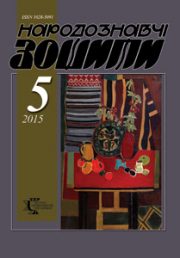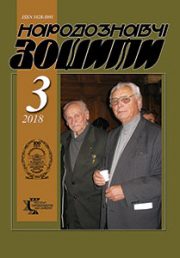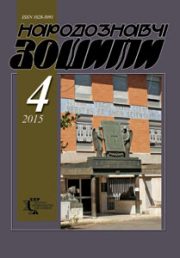The Ethnology Notebooks. 2024. № 1 (175), 180—188
UDK 738.3/.5.071.1.02.03(=161.2:71)”19/20″:929
DOI https://doi.org/10.15407/nz2024.01.180
ARTISTIC FEATURES OF MOSAICS AND CERAMICS IRENA ROMANA NOSYK
PAVLYSHYN Anastasiia
- ORCID ID: http://orcid.org/0000-0003-4316-3144
- Master’s degree of Arts, PhD,
- Lviv National Academy of Arts,
- 38 Kubiyovycha St., 79011, Lviv,Ukraine,
- Contacts: e-mail: pereskokova.nastia@gmail.com
Abstract. The article reveals the artistic features of mosaics and ceramics in the work of Ukrainian diaspora artist Irena Romana Nosyk. The creative output of Irena Nosyk is analyzed with typology according to the genre principle. The first group — mosaics on historical and mythological themes, the second group — animalistic, still life, and landscape mosaic panels; and the third group is abstract compositions. The aims of the work is to rethink skillfully created images in a modern reading. The object of research is artistic mosaic and ceramics as one of the types of decorative and applied art, and the subject is specific works of Irena Nosyk. A comprehensive approach was chosen as the methodological basis of the research, which determined the combination of historical and formal-artistic discourses, with the priority of art historical analysis. The research area covers Canada and Ukraine.
The article gives a general description of the investigated issue of artistic mosaic as one of the types of decorative and applied art. Brief biographical information about the artist and her creative activity is considered. The peculiarities of the mosaic on historical themes are highlighted, in particular the triptych «A word about Igor’s regiment», «Princess Olga», «Prince Volodymyr», «King Danilo» and «Fishing», on mythological themes — «Kupalo», «Lukash and Mavka»; animalistic, still life, and landscape mosaic panels: «Horses», «Sunflower», «Flowers in a blue pot», «Fern flowers», «Flowers», «Forest». Abstract compositions: № 1, № 2, № 3.
Certain regularities are recorded in the work of Irena Nosyk in separating the afterlife, where mythical creatures live, from real life with a pink color that turns into bright green. The originality of the artist’s color and tonal palette is highlighted. Light-shadow contrasts are analyzed. The uniqueness of the secretiveness of the exposition is substantiated in the philosophical and symbolic context, which is connected with the problems of human existence and its inner and outer worlds and the idea of the interaction of beauty and harmony in the universe.
The regularity of the influence of cultural archetypes as permanent images for depiction has been revealed. The general characteristics of the main characters depicted in Mystkin ceramics are given, in particular: animals: rams, horses, peacocks, as well as fantastic beasts, in particular, firebirds; plants: nightshades, oak leaves, grape leaves, viburnum flowers; various geometric shapes: stars, crosses, circles, spirals, lines. The conclusions summarize the research on the work of Irena Nosyk, which is extremely varied and fruitful and is based on professional knowledge of the history of artistic development.
Keywords: artistic features of mosaics and ceramics, art of Irena Romana Nosyk, Ukrainian diaspora in Canada.
Received 15.12.2023
REFERENCES
- Sotska, H., & Shmelova, T. (2016). Mosaics. Dictionary of artistic terms. Kherson: Star[in Ukrainian].
- Shmahalo, R. (2020). Decorative art and eco-design: philosophical and educational foundations of development and modern challenges. Art and Design, 4 (12), 185—194) [in Ukrainian].
- Darevych, D., Nedashkivska, A., & Soroka, M. (Eds.). (2020). Art and the microscope in the life and work of Irena Nosyk. Western Canadian collection (Vol. XLVIII, part 8, pp. 119). Edmonton; Ostrog: Publishing House of the National University «Ostrog Academy» [in Ukrainian].
- Shevchenko, T. (2003). Collection of works: in 6 vol. (Vol. 2, p. 343).Kyiv:Scientific thought[in Ukrainian].
- Kylymnyk, S. (1957). Ukrainian year in folk customs in historical light. Summer cycle (Vol. 4). Winnipeg; Toronto: Ukr. Nats. Vyd. Kom [in Ukrainian].
- Raiska, Y. (2021). Interview with Iryna Tsvilyk-Seryogina. To live (with) art. Retrieved from: https://livingbyart.online/istorii/uzhytkove-mystecztvo/iryna-czvilyk-serohina/ [in Ukrainian].
- Lashchuk, Yu. (1956). Hutsul ceramics. Kyiv: Derzhbudvydav URSR [in Ukrainian].







